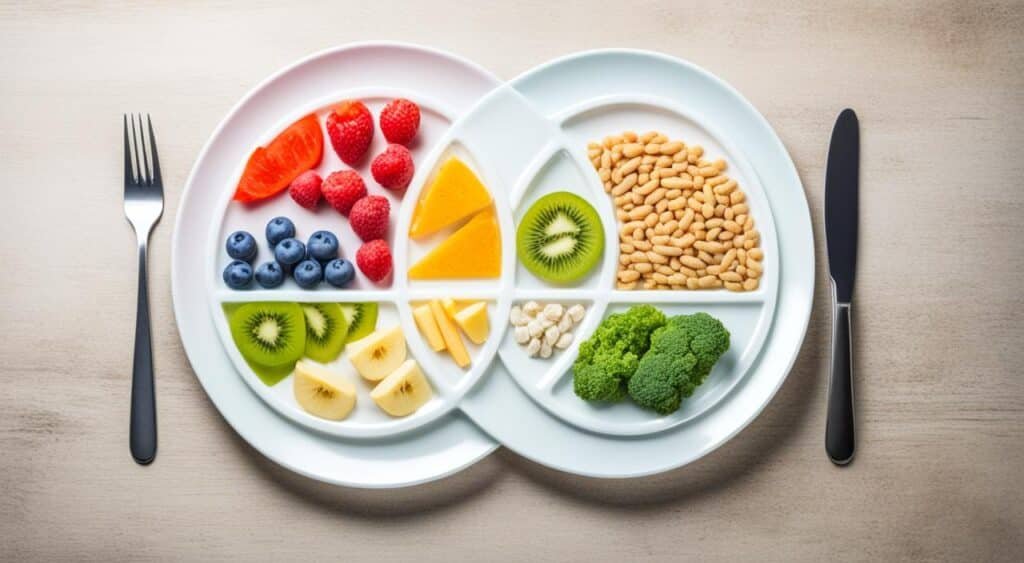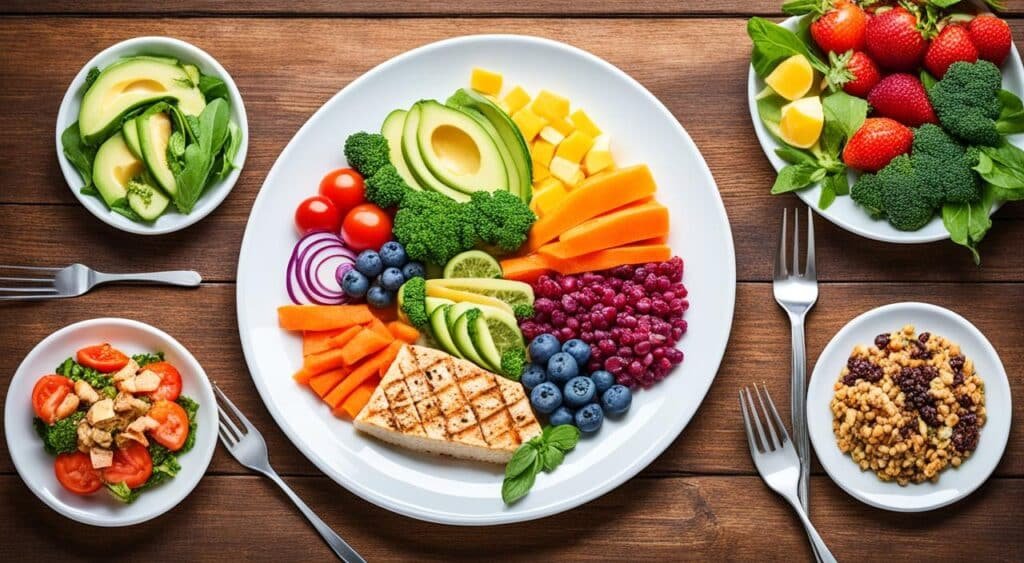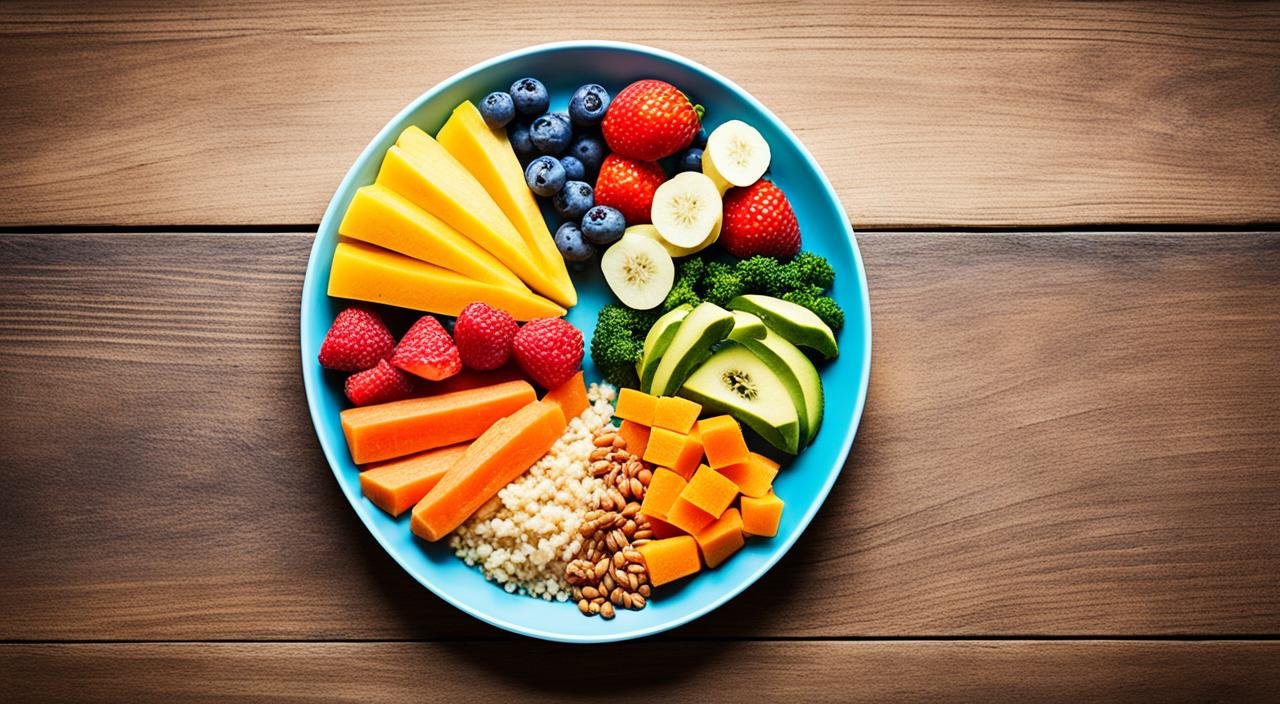Planning healthy meals begins with knowing what your body needs. To create a good nutrition plan, you should understand how many calories and nutrients you require. It’s important to choose a variety of nutrient-dense foods. These include fruits, vegetables, whole grains, lean proteins, and healthy fats.
When we talk about serving size, it’s the usual amount people eat. Portion size, on the other hand, is the amount you serve yourself. It’s key to pick the right portion size based on your body’s needs. This helps keep your diet balanced and reaches your health goals, like weight loss, muscle gain, or feeling better overall.
The plate method is a great way to ensure you’re eating well. It suggests filling half your plate with fruits and vegetables, a quarter with lean protein, and a quarter with whole grains. This method makes sure you get the right amount of macronutrients and micronutrients.
Key Takeaways
- Healthy meal planning involves understanding your body’s specific calorie and nutrient needs.
- Serving size refers to the typical amount of a food or beverage, while portion size is the amount you choose to consume.
- The plate method can help you build a balanced plate with the right proportions of fruits, vegetables, proteins, and grains.
- Incorporating a variety of nutrient-dense foods, such as whole grains, lean proteins, and healthy fats, is crucial for a balanced diet.
- Proper portion control is essential for maintaining a healthy weight and achieving your nutrition goals.
Also Read : What Is Interview Preparation And Why Is It Important?
Importance of Meal Planning for Nutrition
Meal planning is key to keeping a healthy diet. It lets you eat the right nutrients, saves time, and cuts down on food costs. These aspects are vital for reaching your nutrition aims.
Benefits of Meal Preparation
Planning meals early is good for your health. It ensures you eat a variety of healthy foods. This means your diet is well-balanced. You also avoid the bad stuff in fast foods, like a lot of calories and sugar.
Also Read : How Can I Choose The Right College Or University For Higher Education?
Time Management and Convenience
Time management is a big deal in meal planning. It makes your days less stressful. Making meals ahead or in large batches means you’re less likely to grab unhealthy, fast options. This is especially handy if you’re always busy or find it hard to cook each day.
Cost-Effective Meal Planning
Planning meals can save you money. With a good list, you avoid buying things you don’t need. And big, leftover-friendly meals can stretch your budget. So, you get to eat well without spending too much.
Also Read : What Are The Main Causes Of Infectious Diseases?
Assessing Your Existing Food Supply

Before you start meal planning, go through what you have in your kitchen. Check your food inventory closely. Look in the pantry, fridge, and freezer. This way, you’ll know what you can use for meals. It helps you spend less by avoiding buying things you already have. This also cuts down on food waste.
Also Read : How Can STEM Education Benefit Students?
Checking Pantry, Refrigerator, and Freezer
Begin by looking through your pantry, fridge, and freezer. Note the items’ expiration dates and amounts. This step helps in planning meals with what’s on hand. It makes sure you use everything wisely. No need to shop for items you already have.
Utilizing Leftovers and Expiring Items
Also, see if there are any leftovers or foods about to expire. Use them wisely to reduce food waste. This step saves time and money. Use leftovers in new meals or dishes. First, use things that will expire soon.
Also Read : What Are The Basic Interview Techniques?
Creating a Balanced Meal Plan

The key to a balanced meal planning approach is to include all vital food groups. This means eating fruits, veggies, grains, proteins, and dairy or their soy options. Just look at the USDA’s MyPlate for an easy guide. It shows that half your plate should be fruits and vegetables. Then, a quarter should be protein, and the other quarter grains.
Portion Control and Serving Sizes
It’s important to watch portion control and serving sizes for your health. Portion size is how much food you eat, but serving size tells you how much you should eat. Knowing the right portion sizes helps you get the nutrients you need without overdoing it.
Nutrition for Specific Dietary Needs
Some people need to adjust their diet for dietary restrictions or health reasons. For example, those on special diets like gluten-free, vegan, or low-carb must pay attention to what they eat. This helps them stay healthy and feel good. By focusing on your nutritional requirements, you can make a meal plan that fits your health goals and the way you live your life.
Making a Grocery List
First, plan your meals for the week. Then, make a detailed grocery list. To shop quickly and without forgetting anything, sort your list by store sections. Don’t miss the chance to buy items on sale or seasonal produce. It’s a great way to save money and meet your nutrition needs.
Always keep a grocery list, either written or in an app. This way, you remember what to buy when you run out. It helps with budgeting too. You’re less likely to spend on things you don’t need or forget vital items.
Organizing by Store Sections
Group your grocery list into sections like produce, dairy, and frozen foods. This makes shopping easier and faster. You won’t miss any part of the store, saving time. You’re also less likely to retrace your steps or have to come back for missed items.
Considering Sales and Seasonal Produce
Always check for sales and seasonal produce when making your list. Buying items on sale and fresh, seasonal fruits and veggies will save you money. Plus, you’ll be able to add more variety and nutrition to your meals.
Nutrition Meal Planning Strategies

Planning meals well involves more than just making a list for the week. You can make healthy eating a smooth part of your life with some clever tips. Try batch cooking and meal rotation. These strategies make your food plans better and more fun.
Batch Cooking and Meal Prepping
Spend a couple hours on weekends cooking in bulk and prepping. This will save you time when the week gets busy. Making extra food means you can easily warm it up or put it together later. This way, you don’t have to give up on good, balanced meals, even when you’re very busy.
Utilizing Freezer-Friendly Recipes
Using recipes that you can freeze changes everything. Stock your freezer with ready-to-go meals and ingredients. This makes cooking much simpler and always ensures you have healthy choices available. Try freezing dishes in advance to build up a stash that meets your healthy eating needs.
Incorporating Variety and Rotation
Even with strategies like batch cooking, don’t forget to mix things up. Adding a variety of nutrient-rich foods makes your meal plan complete. Changing your meals helps keep things interesting. It lets you taste new foods and enjoy different culinary styles.
Healthy Meal Planning on a Budget
Planning meals is a great way to eat well, even on a tight budget. With the right strategy, you can make meals that are both nutritious and affordable. This is called budget-friendly meal planning.
Buying in Bulk and Storing Properly
Buying non-perishable items in bulk is a smart move for saving money. Things like grains, legumes, nuts, and spices are cheaper in bigger amounts. Also, storing dry goods in airtight containers and freezing fresh foods keeps them good longer. This saves you from throwing food away too soon.
Meatless Meals and Plant-Based Proteins
Choosing meatless meals and focusing on plant-based proteins is budget-friendly and nutritious. Options like beans, lentils, tofu, and quinoa are not only good for you but also versatile. Using these affordable nutrition sources cuts down your grocery costs while helping you eat healthy.
Nutrition Considerations for Different Lifestyles

Thinking about meals involves looking at what each person needs to eat. This is true for families with kids and adults, or for athletes. It’s also important for those with special diets, like food allergies or diabetes. Making meals fit their needs can make everyone healthier and happier.
Meal Planning for Families
Families need a meal plan that fits everyone. Something that works for kids, teens, and grown-ups. It should have a variety of foods like protein, grains, fruits, and vegetables. This mix helps everyone get the nutrition they need.
Nutrition for Athletes and Active Individuals
Athletes and active people need more food and different kinds, too. They rely on foods rich in nutrients to keep them going. Things like lean meats, whole grains, and good fats are vital. They also have to eat and drink right before, during, and after their activities to perform their best.
Special Dietary Requirements
What about people with special dietary needs? For them, it’s about picking what fits. Whether it’s due to food allergies, diabetes, or other health reasons. They have to watch what they eat closely, making sure to get all the right nutrients.
Understanding what each person’s body needs is key to better health. By planning meals for different needs, we can all reach our health goals.
Also Read : Your Trusted Online Health Warehouse For Wellness Needs
Meal Planning Tools and Resources

In our digital age, many tools can make meal planning easier. Things like nutrition tracking apps, meal planning websites, recipe cookbooks and food blogs are everywhere. They help us eat right without as much effort.
Nutrition Tracking Apps and Websites
Apps such as MyFitnessPal and Cronometer help you keep an eye on what you eat. They let you track nutrients and give tips that fit your goals. They’re great for anyone who has special diet needs or wants to do better in sports.
Meal Planning Cookbooks and Blogs
If you need ideas or help with planning, meal planning cookbooks and food blogs are amazing. You’ll find great recipes in cookbooks like “The Complete Cookbook for Healthy Meals.” Popular blogs like Minimalist Baker also offer a ton of options.
Meal Kit Delivery Services
Meal kit delivery services take the work out of cooking. HelloFresh and Blue Apron send you what you need with recipes. They’re perfect for anyone with a busy life or someone who’s just starting to cook. These services are a big help.
Conclusion
Effective meal planning is key to a balanced nutritious diet. Start by looking at the foods you already have. Make a full grocery list and use meal planning strategies. This saves time, money, and makes sure you get all your nutrients.
Eat different, nutrient-dense foods and watch your portion sizes. Fit your meal plan to your life and diet needs. This helps you meet health and wellness goals. With the right help, meal planning can be fun and lasting in your routine.
If you want a balanced diet, save time, money, or have special diet needs, meal planning helps. Follow the advice in this article. It will change how you eat and help you make a personalized nutrition plan. This plan will match your life and what you like.
Everyone’s path to the best nutrition is different. Make your meal planning fit what you need and like. This opens the door to an easy, budget-friendly way of healthy eating. Use meal planning to find a variety of nutritious meals. These meals will care for your body and mind.





